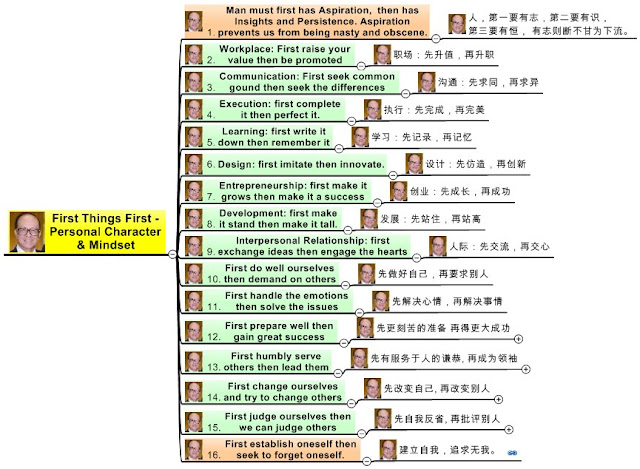A true leader thinks and reacts differently from the common people. When the people are in a panic and don't know what to do, the leader stays calm and works out a course of action that is able to motivate others to go along with him. How is the mindset of a true leader different from the rest? This 4D, Four-Dimensional Thinking Framework show us how:
Here is the visual for 4D Thinking:
The Inner Circle of Vision & Execution
- defining the vision
- plan out the strategies - the popular term used now is called Design
- execute the strategies
- monitor and adapt to the changes to ensure continued movement towards the vision.
The Outer Circle of 4D - Height, Length, Breadth and Depth.
- Height or Positioning
- Length of Time & Distance
- Breadth of Mind and Heart
- Depth of Insights
1. Height or Positioning
A leader must be able to stand above the situation. He does not merely react like others but choose Positivity Response that is able to see the opportunities in the crisis and convert the threats to opportunities. He think above the line - i.e. take charge rather than blame others. He is able to be creative and encourage others to have hope and to move on.
2. Length of Time & Distance
A leader has 4 types of sights:
- Hind-sight that learn from the past successes and failures. He does not repeat the old mistakes. He builds knowledge bases that he could use to enhance his decision making.
- Far-sight to see not only the short term but beyond into the long term. He sees farther than others and is able to work out the implications and side-effects of his decision way into the future, 50 years, 100year and beyond.
- Fore-sight to see before what others could have seen. He defines the future before and for others.
- Radius(Circles) of Influence: He can see what are within his sphere of influence and what are beyond. He continues to work what he can influence to extend his sphere of influence. He does not let those outside his sphere of influence to upset him.
3. Breadth of Mind and Heart
A leader a breadth of mind, open-mindedness, to be able to listen and learn from others; to be able to learn any time, any where and from anyone. He values the views of others, especially of those that are different from him. He synergize diversities rather than merely tolerating them.
He a board-heart, a generosity that love and care for others. He develops others. He cares for right and wrong, fairness and balanced minded, always taking into consideration the multiple parties and views involved and come out with innovative answers and solutions for win-wins for all. He see beyond himself, family, community and into the environment.
He has passion and persistence to continue when others would have given up.
4. Depth of Insights
Most people just see the surface and symptoms missing out the root causes. A true leader find the root causes, dig deep and wide to discover insights, patterns and principles. Hence he can solve problems effectively without short and long-term side-effects
Leadership of the Whole Man
Man is tripartite being of body, mind(soul) and heart(spirit) and live in relationships to one another and to the universe. Any thinking and decision making should always have these 5 factors in mind. The 4D of Height, Length, Breadth and Depth can be apply across the factors of body, mind, heart, community/others and environment/universe. It would be a complex visual to draw and I hope you like my simplification of it as shown above. Will try to improve with time.
Lim Liat (C) 31 March 2012
(Update 4 April 2012) The Version 3.0 Chart:
(Update 18 Sep 2012) The Version 4.0 Chart:
Changes: A Growth Model
(Update 4 April 2012) The Version 3.0 Chart:
(Update 18 Sep 2012) The Version 4.0 Chart:
Changes: A Growth Model
- Height: Added 'Increasing levels of expertise" showing stages of growth.
No one become a great leader at once. Leadership is developed through time. Before a leader can stand at a next higher plane than others, he must learn, starting from novice, to professional and then expert master. We grows from children, young people to parents. In the book of i-Ching, we have a 6-stage model of growth ( Learning from "I-Ching" Part 04 1-乾 Heaven - Creative Force). - Length: Added - The Journey of Reaching a Predetermined Destination.
Life is the journey. The length represents the routes we take, including the de-tours to by pass obstacles, getting lost and finding our way back, but we continue until we reach our destination. - Depth: Added - Identity and Character Building and What You are Made Of
As we grow, we discover and become more assured of our identity. We become more and more stable. We don't sway easily nor give in to external pressure. Ancient Chinese Classics teaches us that leader develops from the inside first and then rule externally.(See Understanding The Great Learning DaXue in One Minute). - Breadth: Added Inclusivity This is a word that captures the essence of Breadth - openness of the mind to welcome ideas and openness of the heart to embrace people of different diversities. It is extending of self to include others of a greater community and the environment too.
Lim Liat (C) 18 Sep 2012








